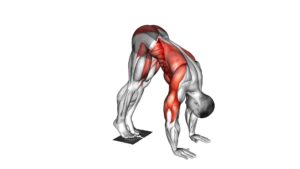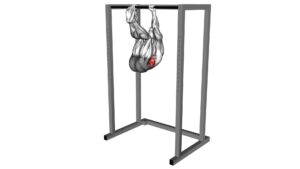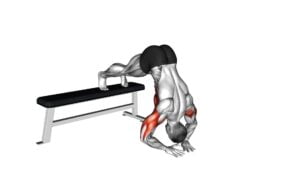Plank to Pike – Video Exercise Guide & Tips

Are you looking to take your fitness routine to the next level? Look no further than the Plank to Pike exercise!
Watch This Exercise Video
This dynamic movement targets your core, shoulders, and legs, helping you build strength and improve stability.
In this article, we'll guide you through proper form, offer modifications for beginners, and challenge advanced fitness enthusiasts with variations.
Plus, we'll share common mistakes to avoid and provide tips to maximize your results.
Let's get ready to plank and pike!
Key Takeaways
- Engages core, shoulders, arms, and legs
- Builds strength, stability, and flexibility
- Prevents boredom and adds variety to workouts
- Targets specific muscle groups and fitness goals
Benefits of the Plank to Pike Exercise
You'll reap numerous benefits by incorporating the plank to pike exercise into your workout routine. Not only does it engage your core muscles, but it also targets your shoulders, arms, and legs. This exercise is highly effective in building strength, stability, and flexibility throughout your body.
One of the great things about the plank to pike exercise is that it can be modified to suit different fitness levels. If you're a beginner, you can start with the basic plank position and gradually work your way up to the full pike position. On the other hand, if you're more advanced, you can add variations such as leg lifts or knee tucks to intensify the exercise.
By incorporating plank to pike variations into your routine, you'll not only challenge your muscles in different ways but also prevent boredom and keep your workouts interesting. Additionally, these modifications allow you to target specific muscle groups and work towards different fitness goals.
Now that you understand the benefits and modifications of the plank to pike exercise, let's move on to the next section, where we'll discuss proper form and technique to ensure maximum effectiveness and prevent injuries.
Proper Form and Technique
To ensure maximum effectiveness and prevent injuries, it's important to maintain proper form and technique while performing the plank to pike exercise. Proper form not only helps you get the most out of the exercise but also reduces the risk of strain or injury.
Here are some common mistakes to avoid and tips for beginners to ensure you perform the plank to pike exercise correctly.
- One common mistake is allowing your hips to sag or lift too high during the pike movement. To maintain proper form, engage your core and keep your hips in line with your shoulders and heels.
- Another mistake is rushing through the exercise without focusing on the quality of each movement. Take your time and concentrate on engaging the correct muscles throughout the exercise.
For beginners, it's important to start with modified versions of the plank to pike exercise. Begin by practicing the plank position and gradually progress to the pike movement. Remember to listen to your body and only push yourself to a comfortable level. As you gain strength and confidence, you can increase the difficulty of the exercise.
Modifications for Beginners
Looking to modify the plank and pike exercises as a beginner? You're in luck!
There are easier variations of the plank that you can try, such as the knee plank or the wall plank, to build your strength and endurance.
Additionally, you can start with gentle pike progressions, like the standing pike stretch or the seated pike stretch, to improve your flexibility and prepare your body for the full pike movement.
Easier Plank Variations
Start with modified plank variations to build strength and stability as a beginner. These easier plank variations will help you develop your core stability and core strength, setting a solid foundation for more advanced exercises. Here are three modifications to consider:
- Knee plank: Start by kneeling on the floor and place your hands shoulder-width apart. Extend your legs behind you, resting on your knees instead of your toes. Engage your core and maintain a straight line from your head to your knees.
- Forearm plank: Begin in a kneeling position and lower yourself onto your forearms, elbows directly beneath your shoulders. Straighten your legs, balancing on your toes. Keep your core tight and maintain a neutral spine.
- Wall plank: Stand facing a wall and place your hands on the wall at shoulder height. Walk your feet back until your body forms a diagonal line. Engage your core and hold this position.
Gentle Pike Progressions
Once you have established a strong foundation with the easier plank variations, it's time to progress to gentle pike modifications that are suitable for beginners.
Pike progression variations are a great way to build core strength and increase flexibility in your hamstrings and lower back.
One modification you can try is the standing pike stretch. Stand with your feet hip-width apart, hinge at the hips, and reach your hands towards your toes while keeping your legs straight.
Another variation is the seated pike stretch. Sit on the floor with your legs extended in front of you, reach your hands towards your toes, and try to touch them without bending your knees.
These pike exercises benefit your entire body by targeting your abs, glutes, and hamstrings.
Advanced Variations for Experienced Fitness Enthusiasts
To challenge yourself further, try incorporating advanced variations into your fitness routine. These advanced modifications will take your plank exercises to the next level, helping you build strength, stability, and endurance. Here are three advanced variations you can try:
- Side Plank with Leg Lift: Start in a side plank position, with your elbow directly under your shoulder and your feet stacked on top of each other. Lift your top leg up towards the ceiling while keeping your core engaged and your hips stable. Lower your leg back down and repeat on the other side. This exercise targets your obliques and hip muscles, adding an extra challenge to your core workout.
- Plank Jacks: Begin in a high plank position, with your hands directly under your shoulders and your body in a straight line. Jump both feet out wide and then back together, similar to a jumping jack motion. Keep your core tight and your back flat throughout the exercise. Plank jacks work your upper body, core, and cardiovascular system, providing a full-body challenge.
- Elevated Plank: Place your feet on an elevated surface, such as a bench or step, while maintaining a plank position. This advanced modification increases the difficulty of the exercise by adding an element of instability. It engages your core, shoulders, and upper body muscles to a greater extent, helping you build more strength and stability.
Incorporating these advanced variations into your fitness routine will push your limits and help you achieve new levels of fitness. Remember to always listen to your body and progress at your own pace. Stay motivated and committed, and you'll see amazing results.
Common Mistakes to Avoid
To avoid common mistakes while performing plank exercises, it's important that you focus on maintaining proper form and technique. By doing so, you can maximize the benefits of this effective core-strengthening exercise.
One common mistake is allowing your hips to sag or lift too high. When your hips sag, it places unnecessary strain on your lower back, while lifting your hips too high reduces the engagement of your core muscles. To maintain proper form, imagine that your body is a straight line from your head to your heels. Engage your core muscles and squeeze your glutes to keep your hips in line with the rest of your body.
Another common mistake is holding your breath during the plank. Remember to breathe steadily and deeply throughout the exercise. Holding your breath can increase tension in your body and make the plank feel more challenging than it needs to be. Additionally, avoid placing your hands too far apart or too close together. Your hands should be directly under your shoulders for optimal stability and support.
Lastly, avoid allowing your shoulders to shrug or your neck to strain. Keep your shoulders relaxed and away from your ears, while maintaining a neutral spine position. This will help prevent unnecessary tension and potential injuries.
By paying attention to these common mistakes and practicing proper form techniques, you can perform plank exercises safely and effectively, achieving the desired results for a stronger core. Remember to listen to your body and make adjustments as needed.
Stay focused, stay motivated, and enjoy the benefits of a solid plank exercise routine.
Tips to Maximize Your Results
To maximize your results with the Plank to Pike exercise, it's important to focus on proper form techniques. This means engaging your core, keeping your body aligned, and avoiding any excessive arching or sagging.
Additionally, target the specific muscle groups by engaging your abs, shoulders, and glutes throughout the movement.
Finally, aim for an effective workout duration by gradually increasing the number of repetitions or holding the plank and pike positions for longer periods of time.
Consistency and proper technique will help you achieve the best results from this exercise.
Proper Form Techniques
To maximize your results, it's important to properly execute the plank to pike exercise with correct form techniques. Here are some tips to help you get the most out of this exercise:
- Common Mistakes:
- Avoid rounding your back during the pike movement. Keep your spine straight and engage your core muscles.
- Don't rush the exercise. Take your time to maintain control and focus on the correct form.
- Avoid lifting your hips too high in the pike position. Aim for a straight line from your head to your toes.
- Effective Workout Duration:
- Start with 3 sets of 10 to 12 reps and gradually increase the intensity as you get stronger.
- Aim for 2 to 3 sessions per week to allow your muscles time to recover and grow.
By following these tips, you'll ensure that you're performing the plank to pike exercise correctly and effectively targeting the desired muscle groups.
Now, let's move on to discuss the target muscle groups in more detail.
Target Muscle Groups
Maximize your results by targeting the key muscle groups with the plank to pike exercise. This challenging movement engages multiple muscle groups simultaneously, making it a highly effective total body exercise.
The plank to pike primarily targets your core muscles, including your abs, obliques, and lower back. As you lift your hips up into the pike position, your shoulders, chest, and triceps also get activated.
The plank to pike variations, such as the single-leg pike or the side plank to pike, add an extra challenge by targeting specific muscle groups in different ways. By incorporating these variations into your routine, you can further enhance your core strength, stability, and overall fitness level.
Effective Workout Duration
Make the most of your workout by focusing on an effective duration. By understanding the optimal exercise duration, you can maximize your results and achieve your fitness goals more efficiently.
Here are some tips to help you determine the right workout length for you:
- Consider your fitness level: Beginners may benefit from shorter workouts to gradually build endurance, while advanced individuals may require longer sessions to maintain intensity.
- Prioritize intensity over duration: A high-intensity workout can be more effective in a shorter amount of time compared to a low-intensity workout that lasts longer.
- Listen to your body: Pay attention to how your body responds to different workout durations. If you feel fatigued or overworked, it may be a sign that you need to shorten or adjust your workouts.
Frequently Asked Questions
How Long Should I Hold Each Position in the Plank to Pike Exercise?
When doing the plank to pike exercise, it's important to focus on form and control rather than holding each position for a specific amount of time.
Start with a plank position and then slowly raise your hips towards the ceiling, forming a pike shape.
Hold the pike position for a brief moment before returning to the plank.
This exercise targets your core, shoulders, and hamstrings, and can improve stability and flexibility.
Can the Plank to Pike Exercise Help With Weight Loss?
The plank to pike exercise can be effective for core strength and can also contribute to weight loss when incorporated into a regular workout routine.
By engaging your core muscles and challenging your stability, this exercise helps to strengthen your abs, back, and shoulders.
Additionally, the dynamic movement involved in the plank to pike exercise can increase your heart rate and burn calories, aiding in weight loss.
Is It Necessary to Warm up Before Performing the Plank to Pike Exercise?
It's important to warm up before performing the plank to pike exercise. A dynamic warm-up can help prepare your muscles and joints for the movement, reducing the risk of injury. It also increases blood flow and flexibility, allowing you to perform the exercise more effectively.
Skipping the warm-up can lead to muscle strains or pulls. Additionally, make sure to avoid common mistakes like rounding your back or collapsing your shoulders.
Stay focused and maintain proper form for maximum benefit.
Are There Any Alternative Exercises That Target Similar Muscle Groups?
Looking for alternative exercises that target similar muscle groups? There are plenty of options out there!
You can try exercises like mountain climbers, knee tucks, or even the jackknife exercise. These exercises all engage the core and work on strengthening the abdominal muscles, just like the plank to pike.
Can the Plank to Pike Exercise Be Modified for Individuals With Lower Back Pain?
If you're dealing with lower back pain, modifying the plank to pike exercise can help. By making adjustments like reducing the range of motion or using a stability ball, you can protect your back while still working your core.
Don't let pain hold you back from improving your core strength. The plank to pike exercise is great for targeting your abs, back, and shoulders, and can lead to improved overall core strength.
Keep pushing yourself and making modifications as needed. You've got this!
Conclusion
In conclusion, the plank to pike exercise is a highly effective way to strengthen your core and improve your overall fitness.
By maintaining proper form and technique, you can maximize your results and avoid common mistakes.
Whether you're a beginner or an experienced fitness enthusiast, there are modifications and advanced variations available to suit your level of expertise.
So, get ready to challenge yourself and achieve your fitness goals with the plank to pike exercise!

Author
Years ago, the spark of my life’s passion ignited in my mind the moment I stepped into the local gym for the first time. The inaugural bead of perspiration, the initial endeavor, the very first surge of endorphins, and a sense of pride that washed over me post-workout marked the beginning of my deep-seated interest in strength sports, fitness, and sports nutrition. This very curiosity blossomed rapidly into a profound fascination, propelling me to earn a Master’s degree in Physical Education from the Academy of Physical Education in Krakow, followed by a Sports Manager diploma from the Jagiellonian University. My journey of growth led me to gain more specialized qualifications, such as being a certified personal trainer with a focus on sports dietetics, a lifeguard, and an instructor for wellness and corrective gymnastics. Theoretical knowledge paired seamlessly with practical experience, reinforcing my belief that the transformation of individuals under my guidance was also a reflection of my personal growth. This belief holds true even today. Each day, I strive to push the boundaries and explore new realms. These realms gently elevate me to greater heights. The unique combination of passion for my field and the continuous quest for growth fuels my drive to break new ground.







